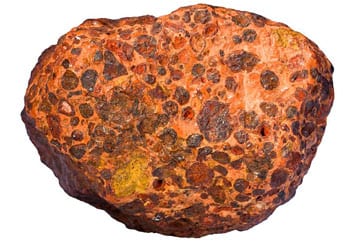Select Language:
Aluminum is the most common metal element found on Earth, totaling about 8% of the Earth’s crust. However, aluminum as an element is reactive and therefore does not occur naturally – it needs to be refined to produce aluminum metal. The primary starting material for aluminum refining is bauxite, the world’s main commercial source of aluminum. Bauxite is a sedimentary rock, and consists mostly of the aluminium minerals gibbsite (Al(OH)3), boehmite (γ-AlO(OH)) and diaspore (α-AlO(OH)), and is usually mixed with the two iron oxides goethite and hematite, the aluminium clay mineral kaolinite and small amounts of anatase (TiO2) and/or ilmenite (FeTiO3).

Bauxite deposits are spread worldwide, mostly occurring in tropical or subtropical regions. Although proven reserves of bauxite are expected to last for many years, the quality of the reserves that can be economically accessed is declining. For refiners, who are in the business of bauxite processing to make alumina, and eventually aluminum metal, this is a challenge with both financial and environmental implications.
The process to refine metallurgical bauxite into alumina involves the following inputs:
The following outputs are generated:

The most widely used chemical process of refining bauxite into alumina, the Bayer process, involves dissolving the Al2O3 out of the bauxite rock with caustic soda (NaOH) at elevated temperature and pressure. The Al2O3 fraction of the bauxite is dissolved into solution, to later be precipitated out as alumina. However, a high-grade bauxite contains up to 60% Al2O3, and many operating bauxite deposits are well below this, occasionally as low as 30-40% Al2O3. Because the desired product is a high purity Al2O3, the remaining oxides in the bauxite (Fe2O3, SiO2, TiO2, Organic material) are separated from the Al2O3 and rejected as alumina refinery resides (ARR) or red mud. In general, the lower quality the bauxite (ie lower Al2O3 content) the more red mud is generated per ton of alumina product. In addition, even some Al2O3 bearing minerals, notably kaolinite, produce un-desirable side reactions during the refining process and lead to an increase in red mud generation, as well as a loss of expensive caustic soda chemical, a large variable cost in the bauxite refining process.
Red mud or ARR represents a large and on-going challenge for the aluminum industry. Red mud contains significant residual caustic chemical leftover from the refining process, and is highly alkaline, often with a pH of 10 – 13. It is generated in large volumes worldwide – according to the USGS, estimated global alumina production was 121 million tons in 2016. This likely resulted in more than 150 million tons of red mud generated during the same period. Despite ongoing research, red mud currently has few commercially viable paths to beneficial re-use. It is estimated that very little of red mud is beneficially re-used worldwide. Instead the red mud is pumped from the alumina refinery into storage impoundments or landfills, where it is stored and monitored at large cost.
The loss of expensive caustic soda (NaOH) and the generation of red mud are both related to the quality of the bauxite used in the refining process. In general, the lower the Al2O3 content of the bauxite, the larger the volume of red mud that will be generated, as the non-Al2O3 phases are rejected as red mud. In addition, the higher the kaolinite or reactive silica content of the bauxite, the more red mud will be generated. The reactive silica content not only increases the volume of red mud, but also consumes caustic soda reagent and reduces the yield of Al2O3 recovered from the bauxite. Therefore, there is both an economic and environmental argument to be made for improving the quality of bauxite prior to refining.
The STET dry separation process offers bauxite producers or bauxite refiners an opportunity to perform pre-Bayer-process upgrading of bauxite ore to improve the quality. This approach has many benefits:
In summary, dry processing with the STET separator offers opportunities to generate value for bauxite producers and refiners. The pre-processing of bauxite prior to refining will reduce chemical costs, lower the volume of red mud generated and minimize process upsets.
References: